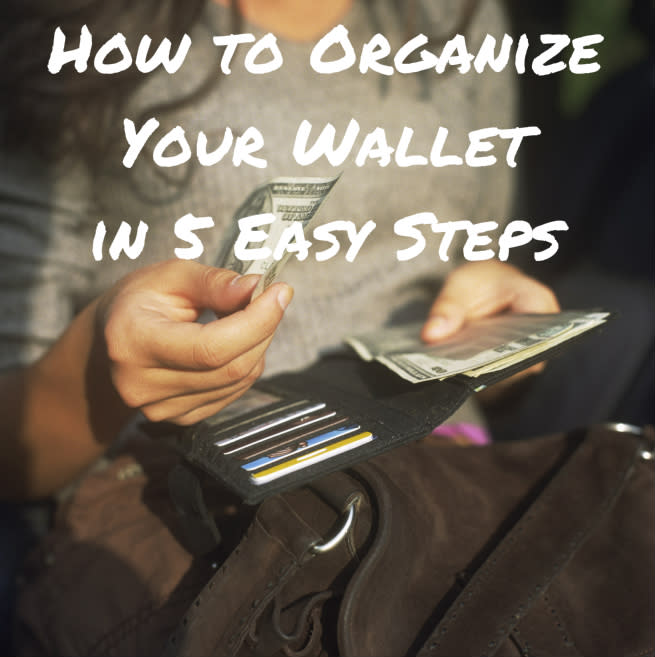A 5-Step Guide to Organizing Your Messy Wallet

Here’s a familiar scenario: You finally bite the bullet and treat yourself to that amazing designer wallet you’ve been keeping tabs on. For a solid week or two, you keep your new purchase pristine and free of clutter, only to slowly start to pack it with extraneous minutiae: Extra cards, loose change, paper scraps, ticket stubs, receipts, and other junk.
MORE: 6 Things You’re Doing That Make You Look Old
Not only can this completely stretch out supple leather and suede, but it also can—as crazy as it sounds—create high levels unnecessary anxiety for you on a daily basis.
More from StyleCaster
Overstuffed bags and wallets hinder you from finding what you need quickly, such as Metrocards (which can cause missed-train stress), key cards to get into your office (resulting in being late), or that $5 bill to buy that latte (which holds up lines, inherently creating stress.)
The good news: Organizing your wallet is way easier than you think. Read on for a 5-step guide to cutting unnecessary clutter right now.
Click here to read the full article.

1. Always utilize the bill holder.
Folding cash sticking it in card slots, the change area, or any other pocket creates a mess—there’s a reason why the long horizontal bill pocket exists. Always make sure your bills are neatly inserted for easy access and exchange.
2. Do a card check.
Take out every card you’re carrying and lay them out on a table, and start to decide if you really need to be carrying every single card every single day. A good breakdown of what’s needed:
Imperative to have daily: Your driver’s license or some form of valid identification (use the plastic ID section if your wallet has one), your health insurance card, your debit/ATM card, the one credit card you use the most, and any card needed to get into your place of work. Organize the cards in pockets according to those you grab most often.
Not needed daily: Secondary or “emergency” credit cards, rewards/discount cards/gift cards (only carry these when you know you’re heading to the retailer), membership cards, library cards, business card you’ve been given, dental and vision insurance cards. Keep these things all together in a pouch at home, so you always know where they are.
MORE: When To Get Rid of Clothes: A 10-Step Guide To Tossing Old Pieces
3. Go through paper scraps
The biggest offender when it comes to messy, unorganized wallets are paper scraps, namely receipts. Of course, it’s inevitable that we’re going to stick receipts on our wallets, but it’s key that you go through and get rid of ones you don’t need weekly.
A good rule of thumb: Throw away receipts for inexpensive items that are already gone at the time of your wallet purge, such as lunch from yesterday, coffee, a pack of gum, or other everyday things. To avoid clutter from these types of scraps completely, it’s perfectly acceptable to tell the cashier that you don’t need a receipt for these items to begin with.
If you’re fastidious about budgeting, hang onto receipts for larger items such as big restaurant meals or bar tabs, fashion purchases, warranties, and household-related things, but keep them in a separate envelope that can easily be referenced. If you need to return an item, only then should you place the receipt into your wallet.
As for other paper scraps—jotted-down addresses, coupons, reminders, phone numbers, etc—throw away anything you won’t need again, as they’ll take up just as much pointless space in a drawer at home as they will in your wallet.
4. Think digitally.
In our digital world, it’s a given that apps exist strictly with the goal of keeping your wallet spic and span. Here are a few to try:
CardStar: A popular free app that allows you to cut wallet and keychain clutter by consolidating all your loyalty and rewards cards.
Lemon Wallet: This free app not only allows you to store digital copies of rewards cards, but also insurance cards, credit and debit cards, coupons, and ID cards. All your data is safely stored and encrypted, and a PIN is required to access your cards. If you lose your phone, you can remotely unlink it from your Lemon account.
Google Wallet: Google’s aptly-named app allows you to send money to anyone in the US with an email address, as well as store your credit and debit cards, loyalty programs, offers, and more.
5. Cut loose change.
Coins not only create crazy amounts of clutter, but they can also seriously weigh you down. Does your wallet have a built-in section for change? Use it! There’s nothing worse than dumping change in the cash pocket, only to have it spill everywhere the next time you pull out a few bills.
If your wallet doesn’t have a specific section, place loose change in a zippered pocket inside your purse. If you don’t find yourself using change often, place coins in a jar at the end of each day and—in a month or so—take it to the bank or bring it to a coin-counting machine, where it turns into cold, hard cash.
Want more tips? Check out our editors’ picks here.
Best of StyleCaster

